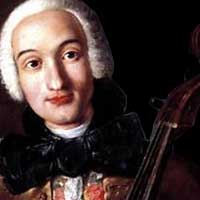Luigi Boccherini Biography - A Very Quick Guide
Luigi Boccherini (February 19, 1743 – May 28, 1805) was a classical era composer and cellist from Italy, mostly known for one particular minuet from one of his string quintets, and the Cello Concerto in B flat major (G 482). This last work was long known in the heavily altered version by German cellist and prolific arranger Friedrich Grützmacher, but has recently been restored to its original version.
Boccherini was born in Lucca, Italy, in a musical family. At a young age his father, a cellist and double bass player, sent Luigi to study in Rome (1757), and after various concert tours, his talents eventually brought him to the Spanish court in Madrid, where he was employed by Don Luis, the younger brother of King Charles III. There he flourished under royal patronage, until one day when the King expressed his disapproval at a passage in a new trio, and ordered Boccherini to change it. The composer, no doubt irritated with this intrusion into his art, doubled the passage instead, leading to his immediate dismissal.
Among his patrons was the French consul Lucien Bonaparte, as well as King Friedrich Wilhelm II of Prussia, himself an amateur cellist, flutist, and avid supporter of the arts. Boccherini fell on hard times following the deaths of his Spanish patron, two wives, and two daughters, and he died in poverty in 1805, being survived by two sons. His blood line continues to this day.
Boccherini is sometimes referred to as the 'wife of Haydn', because much of his chamber music closely resembles the Austrian master's. However, Boccherini is often credited with improving Haydn's model of the string quartet by bringing the cello to prominence, whereas Haydn had always relegated it to an accompaniment role.
A virtuoso cellist of the first caliber, Boccherini often played violin repertoire on the cello, at pitch, a skill he developed by substituting for ailing violonists while touring. This supreme command of the instrument brought him much praise from his contemporaries (notably Baillot, Rode, and Romberg), and is evident in the cello parts of his compositions (particularly in the quintets for two cellos, treated oftentimes as cello concertos with string quartet accompaniment).
He wrote a large amount of chamber music, including over a hundred string quintets for two violins, viola and two cellos (a type which he pioneered, in contrast with the then common scoring for two violins, two violas and one cello), nearly a hundred string quartets, and a number of string trios and sonatas (including at least 19 for the cello), as well as a series of guitar quintets. His orchestral music includes around 30 symphonies and 12 virtuoso cello concertos.
Boccherini's works have been catalogued by the French musicologist Yves Gérard (born 1932), published in London (1969), hence the 'G' numbers for his output.
Boccherini's style is characterized by the typical Rococo charm, lightness, and optimism, and exhibits much melodic and rhythmic invention, coupled with frequent influences from the guitar tradition of his adopted country, Spain. Unjustly neglected, his works have been gaining more recognition lately, in print, record, and concert hall.
Top Pieces on 8notes by Luigi Boccherini
Minuet and Trio
Minuet and Trio
Procession of the Military Night Watch in Madrid (Theme from Master and Commander )
Theme from Master and Commander (Procession of the Military Night Watch in Madrid )
Procession of the Military Night Watch in Madrid (Theme from Master and Commander )
Minuetto from String Quartet
